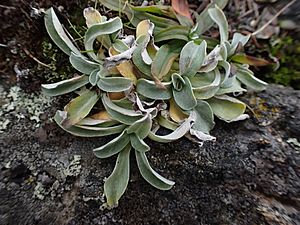Gamochaeta ustulata facts for kids
Quick facts for kids Gamochaeta ustulata |
|
|---|---|
 |
|
| Scientific classification |
Gamochaeta ustulata, often called featherweed or Pacific cudweed, is a type of flowering plant that belongs to the sunflower family. This plant is native to parts of western North America. You can find it growing in the western United States and southwestern Canada, specifically in British Columbia, Washington, Oregon, and California. It mostly grows on hills near the ocean and in the Coast Ranges, but it can also be found further inland.
Contents
What is Featherweed?
Featherweed is a small plant that can be either an annual or a perennial herb. This means it can complete its life cycle in one year and then die (annual), or it can live for more than two years (perennial). It usually grows up to 40 centimeters (about 16 inches) tall.
Leaves and Stems
The leaves of the featherweed plant are about 5 centimeters (2 inches) long. The top side of the leaves is green. But if you look at the underside, it looks white. This white color comes from many soft, woolly hairs that cover the bottom of the leaves. These hairs might be why it's called "featherweed"!
Flowers
Featherweed plants produce many small flower heads. These flower heads grow in long, stretched-out groups. Each tiny flower head has about 4 to 6 yellow disc flowers. Unlike some other plants in the sunflower family, featherweed does not have ray flowers, which are the petal-like parts you see on a typical sunflower.
Where Does Featherweed Grow?
This plant prefers specific places to grow. It is commonly found in areas along the Pacific coast. This includes seaside hills, which are slopes near the ocean. It also thrives in the Coast Ranges, which are mountain ranges close to the Pacific Ocean. While it's mostly a coastal plant, you might also spot it in some areas further away from the coast.
Life Cycle of Featherweed
As mentioned, featherweed can be an annual or a perennial.
- An annual plant grows from a seed, flowers, produces new seeds, and then dies all within one year.
- A perennial plant lives for several years. It can grow, flower, and make seeds year after year without dying completely in winter. This allows it to spread and grow in its habitat over a longer period.

